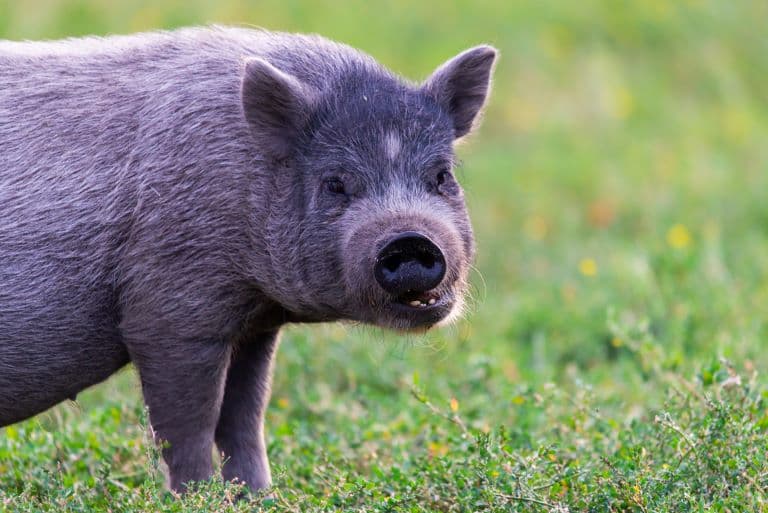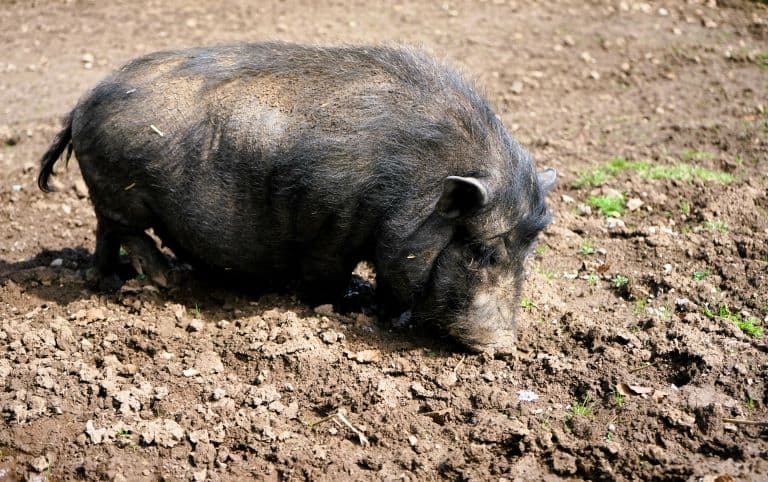Vietnamese Pot-bellied Pig Profile
Sometime around the late ‘80s and early ‘90s, a new fashion emerged in the US. It was a new pet breed, imported from far-off lands, smarter than a dog, cute, too, in that ugly kind of way, and popular because it was different and quirky.
Little did many people know that it was an almost extinct breed that would need to be rescued in its native lands.
Unfortunately, many of these pot-bellied pigs were interbred with other breeds and became enormous. Owners, upon having their couches flipped over, sought to get rid of them and so now these hardy little dorks are all over the world, wreaking havoc on the wildlife.

Vietnamese Pot-bellied Pig Facts Overview
| Habitat: | Domestic |
| Location: | Originated in Vietnam, now worldwide |
| Lifespan: | Up to 20 years |
| Size: | 36 cm (14 in) tall |
| Weight: | Around 50 kg (110 lb) |
| Colour: | Black |
| Diet: | Anything and everything |
| Predators: | None |
| Top Speed: | Slow |
| No. of Species: | 1 |
| Conservation Status: | Endangered (Domestic breed listing) |
Vietnamese pot-bellied pigs are native to Vietnam and have been domesticated from there for thousands of years.
They’re smaller, slower to grow and more resilient than more Western breeds, yet they’re threatened by the competition from the increase in intensive farming practices in Vietnam.
These pigs, like all pigs, are smart, funny, and full of character, which has led to them becoming popular as pets, though feral populations that have resulted from escaped pet pigs now threaten local wild populations in foreign countries.
Interesting Vietnamese Pot-bellied Pig Facts
1. They’re a breed of domestic pig
The Vietnamese pot-bellied pig, known locally as the I pig, is an old domesticated breed of wild pig native to Vietnam. It originates from the Red River delta and is a small, black pig, named after its swaying belly, which can touch the ground in some particularly chunky examples.
Locally, there are two subspecies described, named I-mo and I-pha, the former being the pure I pig: smaller, with shorter legs, than the I-pha, which was crossed with other unknown local breeds to the point where it is now considered a distinct breed.
This one has a less-wrinkled face, is larger and has bigger ears that stick out to the side.

2. They have straight tails
Both these breeds differ from their pinker kin in more ways than just colour. They, ’re significantly smaller, at around a metre long, and don’t usually weigh more than 50kg, unless they’re being bred specifically for meat.
But sticking out of the back end isn’t the characteristic curly tail we see in modern pigs, it’s the kind of tail you’d find on a warthog: long, straight and proud.
They can wag these tails, too, and much like with dogs, there’s a range of expressions involved in this, depending on the specific quality of the wag. 1
3. They once numbered in the millions
Until the ‘70s, this breed of pig would have been the most numerous in Vietnam, with millions of individuals around the country.
But gradually, more productive breeds were introduced, a tide that would have to be stemmed by compensating local farmers who stayed loyal to the local stock. But this had limited effect, and the population of pot-bellied reduced to as few as 120 by 2010, almost going extinct.
Worldwide, by this point, there were several isolated populations dotted about on farms and in zoos, and many made their way into the US via Canada and the breed began to be marketed as a pet.
And for many who have never met a pig, this might seem like a bit of a quirky novelty, but as animals that are significantly smarter than dogs, they make excellent companions. 2

4. Mothers sing to their babies
When nursing, mother pigs utter soft, reassuring grunts to her litter as if to tell them everything’s ok. This sounding off likely embeds the mother’s voice in the piglet’s memory and solidifies bonds, as well as helping them find one another in the busy pig societies that they form in the wild.
5. They might be the smallest breed of pig
Teacup pigs were a thing for a while, but as it turns out, they’re entirely a scam.
It appears that promises of a tiny breed of cute little pigs were in fact just regular piglets that either hadn’t made it to full size yet (and therefore would take up your entire apartment not long after you bought it) or deliberately stunted from birth to remain small and unhealthy.
The smallest recognised breed of pig is, in fact, the Vietnamese pot-bellied pig. These little guys are as tiny as it gets (officially), and not only does this make them extra cute, but it makes them a lot easier to have around your family. 3

6. They make good friends
Pigs are notoriously stubborn animals, and they’re also quite dramatic when they don’t get their way, nonetheless, they are incredibly intelligent, mischievous and affectionate animals and very easy to get along with if you know how to look after their needs.
Potbelly pigs, as many in the ‘90s found out, make great friends. Part of the appeal is that they’re significantly smaller than Western breeds, which can grow to as big as a sofa and are significantly stronger.
While the fad of owning these pigs appears to have died out, their popularity and status as a mascot for pigs everywhere definitely shouldn’t.
Pigs are good people, and they deserve a lot better than we give them! 4
7. They have become invasive
Unfortunately, the swathe of people taking pigs as pets resulted in a bunch of unqualified owners releasing theirs, either by mistake or on purpose, into the wild. And, as the toughest animals around, they made the place their home.
Now, many countries have feral pig populations who are quite happy to ransack the place, eating all the eggs and crops. In some countries, such as Spain, this rampaging has led to them being declared invasive.
Another concern about feral pigs is how sexy they appear to the local breeds. Being an exotic Asian breed makes them particularly appealing to the wild pigs and hybrids happen often.
This dilutes the gene pool of the wild pig and tinkers with the balance of the ecosystem as a result, with potentially dangerous consequences.

Vietnamese Pot-bellied PigFact-File Summary
Scientific Classification
| Kingdom: | Animalia |
| Phylum: | Chordata |
| Class: | Mammalia |
| Order: | Artiodactyla |
| Family: | Suidae |
Fact Sources & References
- “Vietnamese Potbelly Pig”.
- “Detailed History Of The Potbellied Pig ”, North American Pet Pig Association.
- “Vietnamese Pot-Bellied Pig”, Fossil Rim.
- (2015), “Why Pigs are the Best Animals on the Planet”, Kahler Made.
